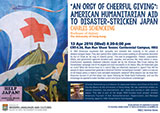
| News & Events |
| 13 April 2016 | |
Seminar: Prof. Charles Schencking 13 April, 2016 (Wed) |
|
In 1923 Americans expressed their sympathy and revealed their humanity to the people of disaster-ravaged Japan. They also opened their wallets and purses creating an atmosphere described by the LA Times as “an orgy of cheerful giving.” This was no exaggeration. Citizens, corporations, NGOs, and government agencies donated cash, supplies, and services like never before or since. Contributions repeatedly shattered collection targets set by the American Red Cross making this humanitarian campaign one of the largest and most successful in US history. Why did Americans give so much? What did donors hope for in return? Was aid effectively deployed in Japan? How did the people of Japan express their gratitude to America? Did this “humanitarian moment “ usher in a new era of US foreign policy or lead to more amicable transpacific relations? What lessons can we draw from America’s tsunami of aid that swept over Japan following the Great Kantō Earthquake, and can this knowledge be applied to better facilitate current and future humanitarian undertakings? |
|
